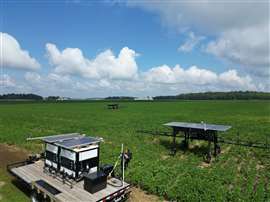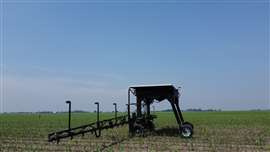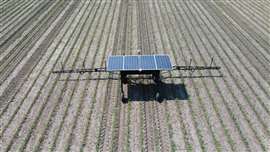Solix Sprayer Robot completes first full-season tests
15 November 2024
Solinftec looks to the future of autonomous crop protection
 When paired with the new docking station, the Solix Sprayer Robot can select from products in blends that are specifically tailored to the conditions the robot finds throughout the field. (Photo: Solinftec)
When paired with the new docking station, the Solix Sprayer Robot can select from products in blends that are specifically tailored to the conditions the robot finds throughout the field. (Photo: Solinftec)
Solinftec’s Solix Sprayer Robots have wrapped up their first full growing season in the Midwestern United States and the company shared some results from the field work. The autonomous machines provide targeted spraying to help reduce chemical inputs, all while collecting data throughout the field.
The first iteration of the Solix robot, introduced in 2022, was designed to scout fields for weed or insect infestations. While that role has remained popular in Brazil, the company’s headquarters country, in the U.S., Solinftec is leading with the Solix Sprayer Robot. It became commercially available earlier this year.
For the 2024 growing season, there were 50 robots in use on wheat, corn, popcorn seed and soybean farms in Indiana and Illinois. Solinftec said the machines monitored more than 65 million plants and applied 15,089 gal. of product with a reduction of up to 98% in herbicide volume. As much as 72,000 gal. of water was saved.
The company said it plans to expand into more states in the Midwest in 2025.
“The Solix Sprayer Robot offers farmers increased efficiency, precision application, data-driven insights and eco-friendly farming practices,” said Taylor Wetli, U.S. Commercial & Business Development manager, Solinftec, West Lafayette, Ind. “Our first season of the Solix Sprayer Robot has achieved expectations and has been met with positive feedback, reinforcing our commitment to transforming agriculture through technology.”
 The Solix Sprayer Robot on display at the company’s stand during Farm Progress Show in Boone, Iowa, in August. (Photo: Chad Elmore)
The Solix Sprayer Robot on display at the company’s stand during Farm Progress Show in Boone, Iowa, in August. (Photo: Chad Elmore)
Seeing those weeds
The robot identifies weeds through cameras and artificial intelligence and surveys the entire field on a plant-by-plant level, providing data on crop populations, weed identification and densities, disease identification and thresholds, insect identification and thresholds, nutrient deficiency identification and densities and other information.
The sprayer is equipped with a 40-ft. boom designed in-house with individual nozzle control. There are two product tanks, with each supporting 12 nozzles down the left and right sides of the boom. Because each nozzle can work independently, one side might see more weeds than the other. When the level in one tank drops below the other, the robot will stop and pump product into the other tank to ensure both are at the same level. The company said each robot has the capacity to treat 5 acres per hour for an average total of 50 acres per day, which equates to 500 acres per season.
Far from being a competitor to traditional application equipment, Solinftec said its sprayer will work alongside traditional machines.
 The Solix Sprayer Robot completed its first full growing season on farms throughout Indiana and Illinois. (Photo: Solinftec)
The Solix Sprayer Robot completed its first full growing season on farms throughout Indiana and Illinois. (Photo: Solinftec)
“There’s always going to be some need for heavy volume spraying applications such as with nitrogen, for example,” said Kyle Gick, project manager, Solinftec. “This isn’t made to be a broadcast sprayer. I see Solix as a partner, in a way, to the larger sprayers. Every time we run across a field and every time one of those nozzles fires, it’s a geo reference point. We’re getting maps that show you where there’s a hot zone of weeds in the field. We can use those maps to help a high-volume sprayer so that it can focus its chemistry on problem areas.”
Solix uses lithium-iron phosphate batteries and four solar panels to provide power for two drive motors in the rear wheels as well as the spray system.
From the time they were introduced, Solinftec has looked for a partner that could take on the assembly of the Solix robots. Through the regional nonprofit organization Wabash Heartland Innovation Network (WHIN), the team met Still Waters Manufacturing and a contract was signed.
Still Waters has 35 years of experience in the support of OEMs, especially in the industrial forklift market. Located in a repurposed school building in rural New Richmond, Ind., the company can reportedly assemble up to 20 robots a day when production ramps up.
Solinftec said the goal for next year is to build 100 Solix robots, bringing the total population up to 150.
Docking station
The technology used in the Solix ag robots has continued to evolve based on feedback from the field. In August, the company announced a docking station that will allow its ag robots to operate without the need for a manual refill.
While not designed to cover an entire field, “large growers will see the benefit of having that docking station, because some growers will have four or five robots out there working and they would need another person to go out there and keep all of them filled,” Gick pointed out. “That’s where the refill base comes into play and helps us expand the use of the robot in a broadcast scenario. We’ll spray 5 or 10 acres and someone doesn’t have to go out there and fill it every 40 minutes.”
The docking station is solar-powered and ensures the robot has access to the necessary products for 24/7 operation in the field. It communicates with each robot in real time.
“Each field has unique characteristics that allow for different weeds
to appear in the field, depending on the stage of the crop,” said Guilherme Guiné, COO for North America, Solinftec. “We designed the docking station to allow Solix to choose the product that will be used based on the recognition of weeds by our artificial intelligence system, Alice AI, enabling the use of specific products for each unique situation.
“Solix has the ability to use a small amount of product in a section of the field and check the crop’s response. Solix can then monitor that area and broaden the scope of application based on results. With this, we will be able to increase the speed of adoption of new products on a large scale, considering the diversity of each field, region and season.”
The company said the concept can be applied to biological products, chemicals, fertilizers and any new product that can offer productivity gains. The docking station will also flush the robot’s tanks autonomously and safely.
Solinftec said it will continue to validate features and concepts as the docking station nears production.
 The Solix Sprayer Robot at work. (Photo: Solinftec)
The Solix Sprayer Robot at work. (Photo: Solinftec)
STAY CONNECTED



Receive the information you need when you need it through our world-leading magazines, newsletters and daily briefings.
CONNECT WITH THE TEAM








